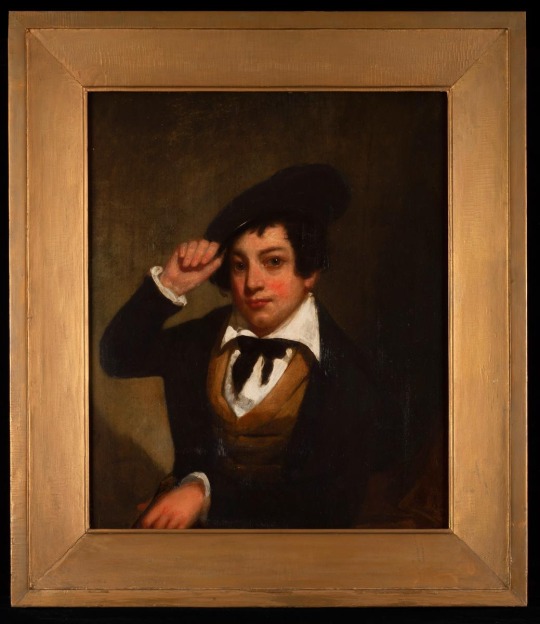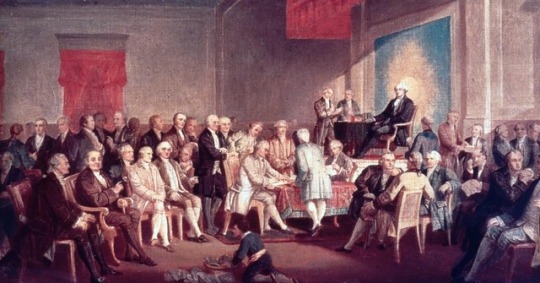#thomas pritchard rossiter
Text
24 Days of La Fayette: Day 5
(I might be really behind schedule, but I will finish what I have started.)

Artist: Thomas Pritchard Rossiter (1818–1871), and Artist: Louis Remy Mignot (American, Charleston, South Carolina 1831–1870 Brighton). Washington and Lafayette at Mount Vernon, 1784 (The Home of Washington after the War). Oil on canvas, 1859. The Metropolitan Museum of Art, JSTOR, https://jstor.org/stable/community.18413572. Accessed 19 Mar. 2024.
Washington and Lafayette at Mount Vernon, 1784 (The Home of Washington after the War) is probably one of the more famous pieces on this list. It was painted 1859 by Thomas Pritchard Rossiter and Louis Remy Mignot. The Mount Vernon Ladies Association was founded in 1853 and there was a renewed interest in Mount Vernon and its history. That is the reason why the pair decided to set their scene at Washingtons home. Mignot was tasked with painting the house and the landscape – a task he took very seriously, he visited Mount Vernon during a painting trip and talked with older people in the area to get the proverbial full picture. Painting the figures fell to Rossiter and while he certainly also did his research, a closer look at the clothing and styling of the figures reveal that it was indeed not a painting done in 1784. Houdon’s bust of Washington supposedly served as a model for the President while an assortment of paintings from Lee University and Washington University served most likely as inspirations for La Fayette and the Custis children.
While there are definitely worse depictions of La Fayette, there are also better ones. The receding hairline is this one very prominent feature that goes a long way of letting La Fayette “look like” La Fayette – but I also find it a bit “lazy” to rely solely on such features (what is rich, coming from a person who can not paint even if my life were to depend on it.)
The composition, a mix of a historical and a genre painting, was very popular at the time. There are also some variations of this painting, especially in print. Here we see depictions of La Fayette arriving, Washington enthusiastically greeting La Fayette or La Fayette leaving Mount Vernon at the end of his stay. While these are all separated works, the parallels between these pieces and the painting at hand are too stark to dismiss the obvious inspiration that was taken from Mignot’s and Rossiter’s work. The historical elements of the portrait depict La Fayette’s third visit to the United States, just after the end of the War. With peace now prevailing he could enjoy his time as a private gentleman and as a friend of Washington at Mount Vernon, away from the horrors of war that had previously occupied him in America. His trip in 1784 would be the last time he and Washington meet in person. But still, La Fayette’s marks are still there, almost 150 years later. The room he stayed to, although afterwards used by countless other guests, is still commonly referred to as the La Fayette room and a copy of Charles Wilsons famous painting adorns the wall.
Rossiter wrote about the painting during the initial exhibition:
The busy portion of the day is over; and, as the long shadows creep slowly over the lawn, the family portion of the household have congregated under the ample portico. The General and his noble guest have arisen from the chairs, which indicate that they had formed a portion of the group with the ladies, and are standing in colloquy: Washington in the act of speaking, and Lafayette leaning against a pillar, in deferential attitude, holds a newspaper in the hand - suggestive that the discourse is a topic of the times.
N.Y.), M.M. of A. (New Y. (1965) American Paintings: A Catalogue of the Collection of the Metropolitan Museum of Art. Metropolitan Museum of Art, pp. 88-90.
#24 days of lafayette#marquis de lafayette#la fayette#french history#american history#history#american revolution#art#george washington#mount vernon ladies association#1784#thomas pritchard rossiter#louis remy mignot
13 notes
·
View notes
Photo

A Studio Reception, Paris (1841). Thomas Pritchard Rossiter (American, 1818-1871). Oil on canvas. Albany Institute of History & Art.
Painted in the artist's Paris studio in 1841, this picture shows nine men surrounding a painter, along with two women who are perhaps posing for the artist. Some believe the scene represents Rossiter himself with his American expatriate friends. Whoever the individuals are, the painting has come to represent American artists' life abroad, showing their close friendship and sense of interdependence.
20 notes
·
View notes
Text

Thomas Pritchard Rossiter (1818 - 1871)
CHARLES DENISON ROSSITER 1839
Fenimore Art Museum
3 notes
·
View notes
Photo

Thomas Pritchard Rossiter (1818-1871), Napoleon Sarony, 1866-1871, Harvard Art Museums: Photographs
Harvard Art Museums/Fogg Museum, Purchase through the generosity of Melvin R. Seiden
Size: photograph: 19.4 x 12.2 cm (7 5/8 x 4 13/16 in.) 27.1 x 17.4 cm (10 11/16 x 6 7/8 in.)
Medium: Albumen silver print mounted on page.
https://www.harvardartmuseums.org/collections/object/98570
1 note
·
View note
Photo

Now that #autumn is finally here, it's the perfect season to enjoy the beauty of our region. The new exhibition "Picturing Niagara" includes depictions of this natural wonder in the museum’s collection by nineteenth-century and contemporary artists. Thomas Pritchard Rossiter kept scrapbooks of reference materials and was often inspired by imagery he encountered in postcards and photographs. Although Rossiter is predominantly known as a portraitist, his early experiences and associations with the founder of the Hudson River School, Thomas Cole, no doubt influenced this painting. The figure of a Native American in the foreground not only indicates the immense scale of the Falls but symbolically mourns the rapidly vanishing American wilderness. [Thomas Prichard Rossiter (American, 1818–1871). "Niagara Falls," ca. 1858. Oil on canvas, 14 1/8 x 25 1/8 inches (35.9 x 63.8 cm). Collection Albright-Knox Art Gallery, Buffalo, New York; Gift of Terry J. Fox in memory of Camille Merlino, 1992.] #AlbrightKnox #NiagaraFalls #Niagara #PicturingNiagara #naturalwonder #buffalo #westernnewyork #art #artist #museum #artmuseum #buffalony #cataract #NiagaraUSA http://ift.tt/2xVCpZz
1 note
·
View note
Photo

#TBT: On this day in 1788, the Constitution became the governing document of the United States. New Hampshire was the ninth of the 13 original states to ratify it. Delaware was the first state to ratify the document. 🎨Thomas Pritchard Rossiter via MPI/Getty Images #TDIH #OTD #throwbackthursday #onthisday #history #news #politics #constitution #cnn https://ift.tt/2K0LsQM
0 notes
Photo

#TBT: On this day in 1788, the Constitution became the governing document of the United States. New Hampshire was the ninth of the 13 original states to ratify it. Delaware was the first state to ratify the document. 🎨Thomas Pritchard Rossiter via MPI/Getty Images #TDIH #OTD #throwbackthursday #onthisday #history #news #politics #constitution #cnn https://ift.tt/2K0LsQM
0 notes